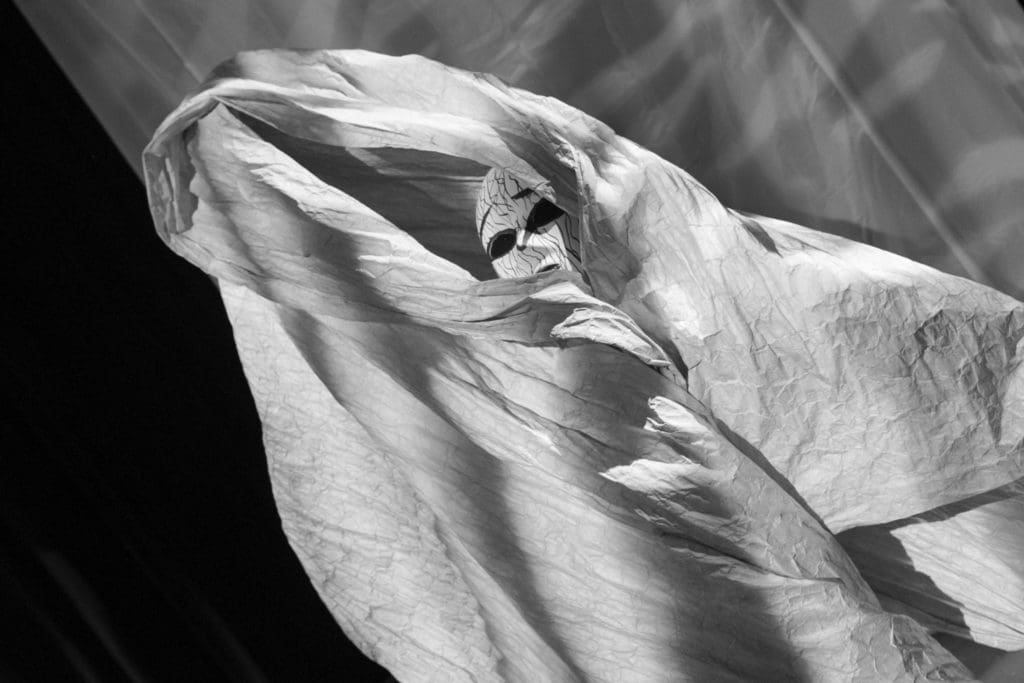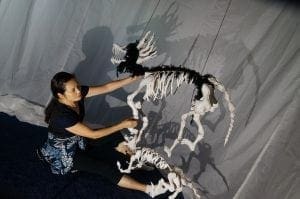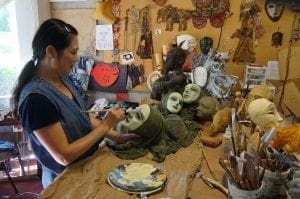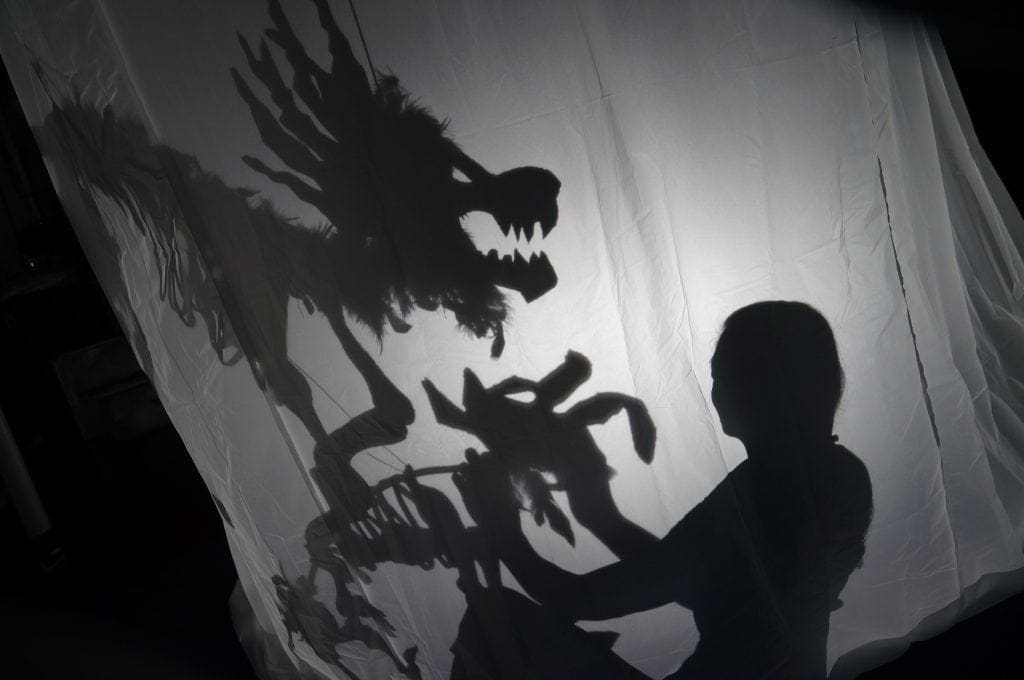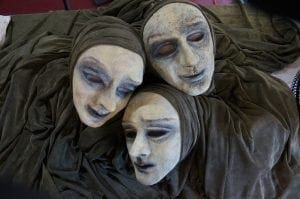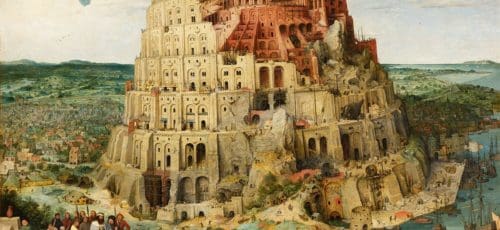East Meets West, Old Meets New: The Dreamlike Beauty of Hua Hua Zhang’s Experimental Puppetry
You enter a room and are surrounded by translucent white. There are strange, undulating formations, and a strange, ghostly light filters down from a hidden source. You feel as if you are on the surface of the moon. Welcome to White Nights, the newest production by Hua Hua Zhang of Visual Expressions. Hua Hua has been working in puppetry for more than thirty-five years, creating productions that are unique in their style and dazzling in their beauty. She aims to combine Eastern and Western art in her work, as well as old traditions with contemporary styles. Her work breaks the boundaries that have defined puppetry for generations, combining it with poetry, visual art, dance, theater, and music. White Nights is an experimental work, a series of dreamlike scenes that can be interpreted in a multitude of ways by the audience, all aiming for a path toward peace of mind. A half-an-hour preview of the show is being shown during the 2017 FringeArts Festival. The final show happens in November.
Images in White Nights make use of individual characters, some of them curious, others in love, others lonely. Produced in the large gallery space of the Asian Arts Initiative, the setting is a giant desert, based on the Chinese poem Night. The audience sits on the ground, around a small “pool of water,” surrounded by pods that serve as Chinese lanterns and shadowy silhouettes from Chinese ink paintings, as well as symbols of a moon and a sun. The puppeteers perform around the audience, who may interact with their movements. Musicians Bhob Rainy and Gamin Kang are also present, playing live music and interacting with the narratives. Four puppet performers, who have been trained in the style developed by Hua Hua, use the stylized movements of traditional Chinese performance, but use the puppets in an entirely different way, showing their entire bodies and moving with their objects. Interactions between the performers and the audience, and between the puppet performers and their puppets, cause constant questioning of their roles: the performer wonders, “Am I manipulating this puppet, or is the puppet manipulating me?” while the audience asks, “Am I watching the show, or am I a part of it?”
The characters inWhite Nights find themselves in the middle of a desert, and explore their environment, which changes throughout the show. There are a paper woman, a rose, a fairy, three masked persons, and a lonely “figure,” who has a magical dance with a balloon. These characters are reminiscent of The Little Prince: they are isolated from any recognizable society, yet they are familiar to us. “I don’t want to tell the audience what to believe,” says Hua Hua. “I want each person to interpret it on their own. I think contemporary art needs the audience involved, being a part of the creation, being a part of the journey, connection with their own journey, instead of just me.” Hua Hua creates each of these puppets in her home studio. She created the lonely “figure,” who has no name, when she was feeling lonely and like many artists used her craft as a cathartic motion. “The moment I feel that, I do the sculpture. I made the whole figure simple, with just one leg. When I’m making the piece, I don’t realize the origin. Art can release you, and tell you, you have something to show. It’s kind of a ghost—intuition or instinct.” She follows the character of the puppet that she’s created to build the scene. “Sometimes, when I’m first creating the sculpture, I have no story, but my sculpture tells me the story. If I see, he’s a little sad, I follow the sadness, and I get a sad story.” Another puppet she made appeared as if he was looking for something. “This is the curious puppet, and he is a dreamer. I wanted to explore immigration. We dream. We dream about America, we dream about it being beautiful and creating freedom. He’s so curious. That is where I come in. I’m curious! What does this country look like? What is it like to be an artist, with a freedom of expression?”
While Hua Hua is highly skilled in the creation and performance of her puppets, she was not able to fully express herself when living in China. “It was very controlling at that time, twenty years ago. I wanted to be an artist but they assigned me as a performer. I wasn’t even a sculptor but I wanted to make sculptures and paint.” She was able to make visual art after coming to the United States. She had trained at the Beijing Academy of Performing Arts, but in 1996, joined the University of Connecticut for a Masters of Fine Arts in Puppet Art. At the time, it was the only program of its kind. As a student, she started sculpting and painting, and her professors found that she had an innate talent for making visual art. “I didn’t even know I had it inside of me.” She began creating puppets and developed an individual style, using the entire body to interact with the puppet. Later, she attended a workshop with legendary puppet artist Albrecht Roser. “I wanted to manipulate the puppet, and I wanted to learn how to control it, but he said, ‘Everybody, listen. Sometimes, you have to listen to the puppet, the puppet will tell you.’ It was very spiritual.” His work influenced hers, and she found that after creating a puppet, the goal of the puppet performer is to follow the whims of the character inside that object, rather than manipulating it completely. “I’m performing, but still, I feel it through me. I give the transition for the soul for the object.” Their entire body is often visible, unless occasionally hidden by long sheets of fabric that still move dynamically with the angles of the performer.
This is where Hua Hua Zhang’s shows become remarkably interdisciplinary. In order to be effective as one of her puppeteers, you must be highly skilled in dance and theater, as well as puppetry. She trains many of the performers that work with her, and is currently training the three in the show. “The movement is very stylized. You need to make sure you see, you think, you react, and then see again. You have to have both dance, and thought. I was working with theater, and it was a journey.” One of these performers is Elizabeth Weinstein, a Philadelphia-based movement artist, educator, and doula. Another is Travis Daniel Draper, who is trained in physical theater and animation. The third is Jeanne Lyons, who is an interdisciplinary performing artist. Both Jeanne and Travis study at the Pig Iron School for Advanced Performance Training, while Elizabeth completed her study at the Headlong Performance Institute. Hua Hua enjoys working with actors like them immensely, who are still relatively new to the world of performance, and are excited about the unique opportunities that puppetry has for the theater.
The production combines all of these elements with original music. Again combining east and west, old and new, the two musicians will play their work live. Bhob Rainey (also composing for the Fringe Festival curated show Hello Blackout!) uses electronics in much of his music, and is intertwining these sounds with those of Gamin Kang. One of the most celebrated traditional musicians in South Korean, Gamin is the yisuja of the Intangible Cultural Asset Number 46 for two instruments, the piri and the daechita. She also plays a Korean oboe called the taepyeongso and the saengwhang, an ancient wind instrument. A fourth puppet performer, Chad Williams, is intertwining his more traditional puppet style into the show. “He has a very standard, American hand-puppet style. I want to experiment by putting it into my Eastern show, and blend them together.”
Hua Hua is constantly pushing forward the boundaries of puppetry and its potential. “I want to honor the tradition of puppetry as well as take a risk to push the limits of traditional puppetry into the contemporary. Most people see puppet art with a narrow vision,” she says. “Puppetry is considered entertainment for children that can be performed by anyone.” In order to explore its potential, Hua Hua explaiins that people must understand that puppetry is all about movement, not just in the hands. She teaches through the stylized performance art of the Chinese theater. “I teach my students that their feet are the connection to the earth, and sending the energy through their body to the puppet, to give a soul of puppet life.” Her puppets are not controlled by strings, or stuck onto poles. Instead, they are sometimes in the forms of masks, or large beings suspended on various sticks. While they look simple in form—albeit complicated in the detail on their faces—learning the performance to master their technique takes time and practice.
 Finding the “soul of the puppet” is the ultimate goal for her puppet performers, again asking themselves if they are controlling the puppet, or if the puppet leads them to move. Hua Hua was inspired by an ancient Taoist philosopher, Zhangzi. “He had a dream that he had become a butterfly, and derived pleasure from flying. After he awakened, he asked whether he dreamed he was a butterfly, or if the butterfly was dreaming that he was a man,” she says. “This ambiguity is explored throughout the show by blurring the line between reality and dream.” While her art acts as a meditation on her life experiences, it aims to do the same for anyone watching the show. “The show connects my life experiences and the experiences of others with today’s society, issues, and concerns. It connects with audience members, giving them inspiration to explore their true selves and, hopefully, find balance and inner peace.”
Finding the “soul of the puppet” is the ultimate goal for her puppet performers, again asking themselves if they are controlling the puppet, or if the puppet leads them to move. Hua Hua was inspired by an ancient Taoist philosopher, Zhangzi. “He had a dream that he had become a butterfly, and derived pleasure from flying. After he awakened, he asked whether he dreamed he was a butterfly, or if the butterfly was dreaming that he was a man,” she says. “This ambiguity is explored throughout the show by blurring the line between reality and dream.” While her art acts as a meditation on her life experiences, it aims to do the same for anyone watching the show. “The show connects my life experiences and the experiences of others with today’s society, issues, and concerns. It connects with audience members, giving them inspiration to explore their true selves and, hopefully, find balance and inner peace.”
White Nights
Hua Hua Zhang/Visual Expressions
$10 / 30 minutes
Asian Arts Initiative: Dance Studio C
1219 Vine Street
Sept 19 at 7:30pm + 9pm
—Isabella Siegel
Photos: Richard Termine (banner, second photo, and last photo,) Hua Hua Zhang (sixth photo,) and Adam Danoff (all other photos)

